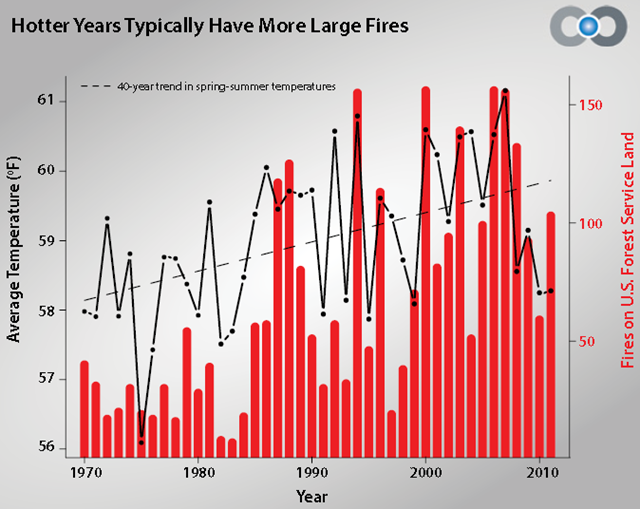Graph of the Day: Average Surface Temperatures and Number of Wildfires in the U.S. West, 1970-2010
When we compared the average annual spring and summer (March-August) temperatures to the number of large wildfires burning across all 11 Western states, we observed a relationship similar to that reported by Westerling, et al.; years with higher-than-average spring and summer temperatures also tended to be years with more large fires. Seasonal temperatures are a key determinant of annual wildfire risk. Long stretches of warm weather in the spring and summer dry trees and brush, making them both easier to ignite and more likely to burn. Additionally, warmer spring temperatures can cause mountain snowpack to melt earlier and, when followed by a hot summer that keeps moisture out of the ground, these higher temperatures create ideal conditions for big fires. Westerling, et al. primarily attributed the changes he observed in wildfires to warming spring and summer temperatures and earlier melting of snowpacks in Western mountain ranges. Average annual temperatures across the contiguous U.S. have warmed about 1.3oF in the past 100 years, but warming has been even higher in the West, rising 1.8oF over that same time period. Increasing spring and summer temperatures across Western states since 1970 have been particularly dramatic (Figure 7). Spring has warmed approximately 1.9oF and summer has warmed about 1.6oF, with the Southwestern states of Arizona, Colorado, New Mexico, and Utah seeing some of the fastest rising spring and summer temperature trends. In recent years, researchers have begun to investigate how human-induced climate change has influenced wildfires. The warming across North America over the second half of the 20th century has been attributed, in part, to rising concentrations of greenhouse gases in the atmosphere. At the regional level, however, the precise degree to which human activity has influenced the increase in spring and summer temperatures is unknown. While Westerling and others have shown a strong correlation between these rising temperatures and increasing wildfire activity, there are other natural and human factors that likely play an important role in these observed changes in wildfires trends.
